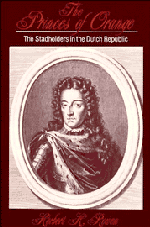Book contents
- Frontmatter
- Contents
- List of illustrations
- Preface
- Prologue: lieutenants of the crown
- 1 William I: from courtier to rebel
- 2 Maurice of Nassau: defender of the Republic
- 3 Frederick Henry: firm in moderation
- 4 William II: the challenger
- 5 The first stadholderless period: 1 exclusion
- 6 The first stadholderless period: 2 return
- 7 William III: stadholder and king
- 8 The second stadholderless period: doldrums
- 9 William IV: neither revolutionary nor reformer
- 10 William V: the era of Anna and Brunswick
- 11 William V: the Patriot challenge
- Epilogue: consequences and conclusions
- Bibliography
- Index
- Title in series
Epilogue: consequences and conclusions
Published online by Cambridge University Press: 01 June 2011
- Frontmatter
- Contents
- List of illustrations
- Preface
- Prologue: lieutenants of the crown
- 1 William I: from courtier to rebel
- 2 Maurice of Nassau: defender of the Republic
- 3 Frederick Henry: firm in moderation
- 4 William II: the challenger
- 5 The first stadholderless period: 1 exclusion
- 6 The first stadholderless period: 2 return
- 7 William III: stadholder and king
- 8 The second stadholderless period: doldrums
- 9 William IV: neither revolutionary nor reformer
- 10 William V: the era of Anna and Brunswick
- 11 William V: the Patriot challenge
- Epilogue: consequences and conclusions
- Bibliography
- Index
- Title in series
Summary
Almost two decades would pass after the departure of William V for England before the House of Orange returned to the Netherlands. During that eventful time the country's political institutions were ripped away and discarded, and in their stead came a variety of forms, democratic, parliamentarian and autocratic. The Batavian Republic was first, installing a new regime on the cleared ground. The historic provinces lost their sovereignty, giving way to a unitary national government. National and local officials were elected, although the range of the electorate varied with shifting political developments. Like citizenry, taxation too became national. The regime was not able to achieve stability. It swung to the left, to the right, and finally had an authoritarian head imposed on it by the Emperor Napoleon. From 1805 to 1810 Napoleon's brother Louis ruled as king of Holland. From 1810 to 1813 the ruler was Napoleon himself, after the country was incorporated into the French Empire. In 1813, as the Empire began to disintegrate, Dutch independence was proclaimed, and William V's son returned, first as Sovereign Prince and then as King William I of the Netherlands. But the old regime did not come back with him. The new institutions were maintained, which over the decades were transformed into the modern constitutional monarchy.
- Type
- Chapter
- Information
- The Princes of OrangeThe Stadholders in the Dutch Republic, pp. 230 - 232Publisher: Cambridge University PressPrint publication year: 1988

